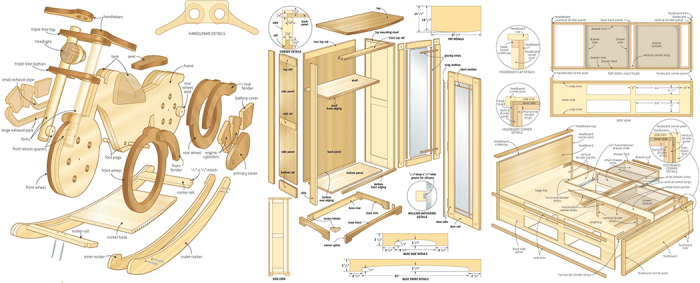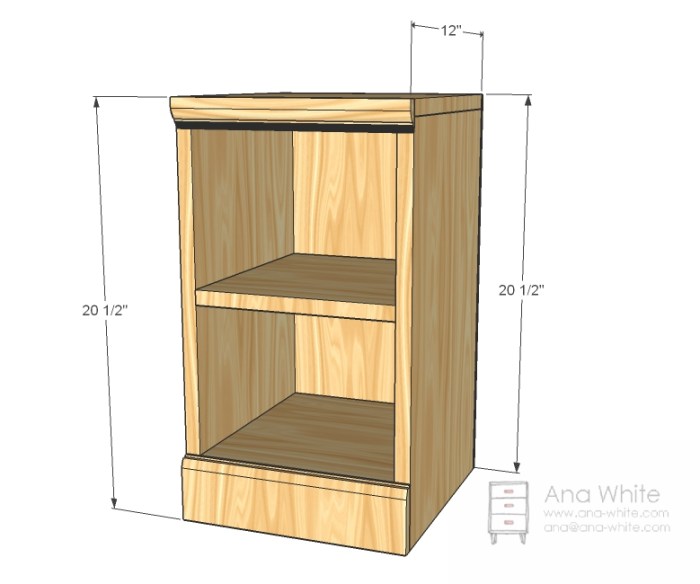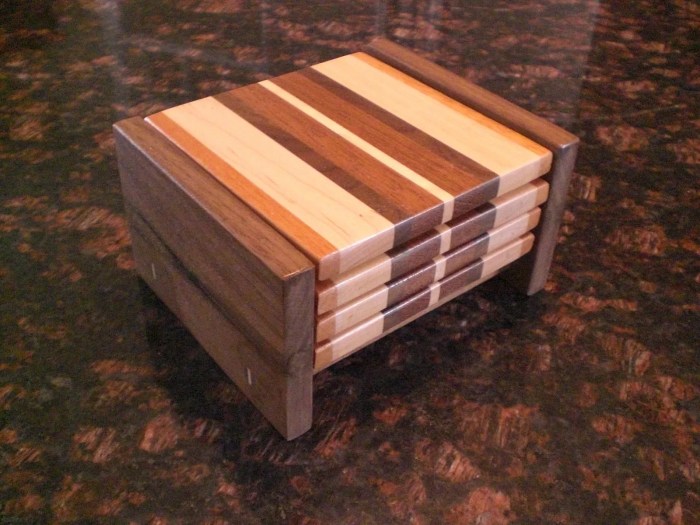Beginners woodworking plans offer a gateway into the rewarding world of crafting with wood. Whether you’re drawn to the satisfaction of building something with your own hands or simply want to explore a new creative outlet, woodworking can be an enjoyable and fulfilling hobby. These plans provide step-by-step guidance, helping you navigate the fundamentals of woodworking, from selecting the right tools and materials to executing basic techniques.
This guide will cover the essentials for getting started, including choosing the right plan for your skill level, understanding woodworking terminology, and learning how to use common tools safely and effectively. You’ll also find resources for finding inspiration, connecting with other woodworkers, and expanding your woodworking knowledge.
Introduction to Woodworking for Beginners

Woodworking is a rewarding hobby that allows you to create beautiful and functional items for your home or as gifts. It can be a challenging but enjoyable way to express your creativity and learn new skills. Whether you are a complete beginner or have some experience, this guide will provide you with the fundamental knowledge and techniques to get started.
Basic Tools and Equipment
It’s essential to have the right tools and equipment for woodworking projects. The following are some basic tools that every beginner should have:
- Hand saw: Used for cutting wood to size.
- Measuring tape: Essential for accurate measurements.
- Hammer: Used for driving nails and other tasks.
- Screwdriver: For fastening screws.
- Chisel: For carving and shaping wood.
- Sandpaper: For smoothing and finishing wood surfaces.
- Clamps: For holding pieces of wood together while working.
- Safety glasses: To protect your eyes from wood chips and dust.
- Work gloves: To protect your hands.
Setting Up a Safe and Organized Workspace
Having a safe and organized workspace is crucial for successful woodworking. Here are some tips:
- Choose a well-lit and ventilated area: Adequate lighting is essential for accurate work, and ventilation helps to remove dust and fumes.
- Keep your workspace clean and tidy: Regularly clear away debris and tools to prevent accidents.
- Use a workbench: A sturdy workbench provides a stable surface for working on projects.
- Store tools and materials properly: Keep tools sharp and organized, and store materials in a dry and well-ventilated place.
- Always wear safety glasses and gloves: This will protect you from injury.
Types of Wood Commonly Used in Woodworking Projects
Different types of wood have varying characteristics and are suitable for specific woodworking projects. Some common types of wood used in woodworking include:
- Softwoods: Pine, fir, spruce, cedar, and redwood are softwoods that are typically lightweight and easy to work with. They are often used for construction, furniture, and crafts.
- Hardwoods: Oak, maple, cherry, walnut, and mahogany are hardwoods that are denser and more durable than softwoods. They are commonly used for furniture, flooring, and decorative items.
- Plywood: A layered wood product made from thin sheets of veneer glued together. Plywood is strong, stable, and affordable, making it suitable for a wide range of woodworking projects.
- MDF (Medium-Density Fiberboard): A wood-based panel made from wood fibers bonded together with resin. MDF is smooth, dense, and easy to work with, but it is not as durable as hardwood.
Essential Woodworking Techniques

Mastering fundamental woodworking techniques is crucial for creating beautiful and functional projects. From accurately measuring and cutting wood to understanding different joint types, these skills form the foundation of your woodworking journey. Let’s delve into some essential techniques that will help you confidently tackle your woodworking projects.
Measuring and Cutting Wood
Precise measurements are essential for accurate woodworking. Here’s how to measure and cut wood effectively:
* Choosing the Right Measuring Tool: A tape measure is indispensable for woodworking. Ensure it’s in good condition, with clear markings and a sturdy hook. For smaller measurements, a ruler or combination square can be helpful.
* Marking the Cut: Use a pencil or marking knife to clearly mark the cut line on the wood. Ensure the mark is precise and aligns with your measurements.
* Using a Saw: Select the appropriate saw for your project. A handsaw is versatile for general cutting, while a miter saw provides precise angles. When cutting, use a firm grip and apply even pressure to avoid splintering.
* Safety First: Always wear safety glasses and gloves when working with wood. Keep your fingers away from the saw blade and work on a stable surface.
Basic Woodworking Joints
Wood joints connect different pieces of wood, creating structural integrity and aesthetic appeal. Here are some common woodworking joints:
* Butt Joints: The simplest joint, a butt joint connects two pieces of wood end-to-end. While easy to create, it’s not the strongest joint due to its lack of interlocking surfaces.
* Dado Joints: A dado joint is a groove cut into one piece of wood to receive the end of another piece. This creates a strong and flush joint.
* Mortise and Tenon Joints: A mortise and tenon joint is a strong and versatile joint. It involves cutting a rectangular hole (mortise) in one piece of wood and a corresponding tenon (projection) on the other piece. The tenon fits snugly into the mortise, creating a robust connection.
Sanding and Finishing Wood
Sanding and finishing are crucial for achieving a smooth and polished look for your woodworking projects. Here’s a step-by-step guide:
* Sanding: Begin with coarse-grit sandpaper to remove any rough edges or imperfections. Gradually progress to finer grits for a smoother finish. Sand with the grain of the wood to avoid scratches.
* Finishing: Choose a finish that suits your project’s needs and desired look. Options include stains, paints, varnishes, and oils. Apply the finish evenly and allow it to dry completely before handling.
Beginner Woodworking Projects

Starting with simple projects is a great way to gain confidence and develop your woodworking skills. These projects are designed to be achievable for beginners, allowing you to learn basic techniques and familiarize yourself with common woodworking tools.
Simple Woodworking Projects for Beginners
Here are some beginner-friendly woodworking projects that are perfect for starting your woodworking journey:
- Wooden Box: A simple wooden box is a great first project, as it allows you to practice basic cuts, joinery, and finishing techniques. You can customize the size and design of the box to fit your needs and preferences.
- Birdhouse: Building a birdhouse is a fun and rewarding project that can be enjoyed by people of all ages. It’s a relatively simple project that allows you to practice cutting, drilling, and assembling wood.
- Cutting Board: A cutting board is a practical and useful project that can be customized with different woods and designs. You can practice basic cuts, sanding, and finishing techniques while creating a functional piece for your kitchen.
- Small Shelf: A small shelf is a simple project that can be used to display items or add storage space to your home. You can learn how to create simple joints, attach shelves to supports, and finish the wood.
- Picture Frame: A picture frame is a great project for practicing precise cuts and mitering. You can learn how to assemble a frame using simple joinery and finish it with a variety of techniques.
Detailed Steps for Building a Simple Wooden Box
This table provides a step-by-step guide for building a simple wooden box:
| Step | Description |
|---|---|
| 1. | Cut the Wood: Cut the wood for the sides, bottom, and top of the box to the desired dimensions. Use a saw or a table saw for accurate cuts. |
| 2. | Assemble the Sides: Join the sides of the box together using glue and nails or screws. You can use a miter saw or a jigsaw to create angled cuts for a more finished look. |
| 3. | Attach the Bottom: Attach the bottom of the box to the sides using glue and nails or screws. Ensure the bottom is flush with the sides. |
| 4. | Attach the Top: Attach the top of the box to the sides using glue and nails or screws. If you want a removable top, you can use hinges or a simple latch. |
| 5. | Sand and Finish: Sand the box smooth using sandpaper, starting with coarse grit and finishing with fine grit. Apply a finish of your choice, such as paint, stain, or varnish. |
Beginner-Friendly Woodworking Plans Available Online
There are many online resources available that offer free woodworking plans for beginners. Here are a few websites that provide detailed instructions and diagrams for various projects:
- Ana White: Ana White’s website offers a wide variety of woodworking plans, including many beginner-friendly projects. https://www.ana-white.com/
- The Woodworking Shop: The Woodworking Shop website features a collection of woodworking plans for all skill levels, including beginner-friendly projects. https://www.thewoodworkingshop.com/
- Woodworking for Mere Mortals: This website offers a comprehensive library of woodworking plans, tutorials, and articles, including a section dedicated to beginner projects. https://www.woodworkingformere%20mortals.com/
- Instructables: Instructables is a popular website that features a wide range of DIY projects, including many woodworking plans. You can find beginner-friendly projects by searching for s like “woodworking for beginners” or “easy woodworking projects.” https://www.instructables.com/
Choosing the Right Woodworking Plans

You’ve got the tools, you’ve got the desire, and you’re ready to dive into woodworking. Now it’s time to choose the right plan to guide your first project. Selecting the perfect woodworking plan is crucial, as it can make the difference between a successful project and a frustrating experience.
Factors to Consider When Choosing Woodworking Plans, Beginners woodworking plans
When choosing woodworking plans, several factors are essential to consider. These factors will ensure that the project you select aligns with your skill level, available tools, and desired outcome.
- Skill Level: Woodworking plans are often categorized by difficulty, ranging from beginner-friendly to advanced. Starting with a project that matches your skill level is crucial. If you’re new to woodworking, look for plans labeled “beginner” or “easy.” As you gain experience, you can graduate to more complex projects.
- Project Complexity: Consider the number of steps, joinery techniques, and overall complexity of the project. Choose a project that fits your available time and attention span. A simple project is often more rewarding than a complex one that you may abandon halfway through.
- Available Tools: Review the tools listed in the plan’s materials list. Ensure you have the necessary tools or are willing to invest in new ones. Starting with a project that utilizes tools you already own will make the process smoother and less expensive.
Types of Woodworking Plans
Woodworking plans come in various formats and sources, each offering unique benefits and drawbacks.
- Free Plans: Many websites and blogs offer free woodworking plans. These plans can be a great way to start, but they may lack the detail or professional guidance of paid plans. Free plans often come with a disclaimer that they are provided “as is” and may not include comprehensive instructions or detailed diagrams.
- Paid Plans: Paid woodworking plans are often more detailed and comprehensive than free plans. They typically include detailed instructions, diagrams, cutting lists, and even material recommendations. These plans are a valuable investment for serious woodworkers, as they offer a higher level of support and guidance.
- Plans from Woodworking Communities: Many woodworking communities offer a vast library of plans, often shared by members. These plans can be a great way to connect with other woodworkers and learn from their experience. However, the quality of plans within a community can vary, so it’s essential to review the plan thoroughly before starting a project.
Tips for Interpreting and Understanding Woodworking Plans
Reading and understanding woodworking plans can seem daunting at first, but with practice, it becomes easier. Here are some tips to help you interpret and understand woodworking plans effectively.
- Read the Instructions Carefully: Before you start cutting wood, take the time to read the instructions thoroughly. Pay attention to the order of steps, safety precautions, and any special techniques required. It’s often helpful to read the instructions more than once to ensure you understand each step.
- Study the Diagrams: Woodworking plans typically include diagrams that show the overall project layout, individual parts, and joinery techniques. Take the time to study these diagrams carefully. If you’re unsure about a specific detail, ask for clarification or seek guidance from a more experienced woodworker.
- Create a Cutting List: Before you start cutting wood, create a cutting list that includes the dimensions and quantities of each piece. This will help you organize your materials and ensure you have everything you need. You can also use a cutting list to keep track of your progress and avoid cutting the same piece multiple times.
Resources for Beginners
Learning woodworking can be an exciting journey, and the right resources can make it even more enjoyable and rewarding. This section will guide you through valuable resources that can help you learn and grow as a woodworker.
Online Communities and Forums
Online communities and forums provide a platform for woodworkers of all skill levels to connect, share knowledge, and seek guidance. Engaging with these communities offers a valuable opportunity to learn from experienced woodworkers, ask questions, and get feedback on your projects.
- Woodworking Forums: These forums are dedicated to woodworking, where you can find discussions on a wide range of topics, from basic techniques to advanced projects. Popular woodworking forums include:
- Lumberjocks: A large online community with a focus on woodworking, offering forums, project galleries, and a marketplace for woodworking supplies.
- The Woodworking Forum: A forum dedicated to all aspects of woodworking, featuring discussions, project plans, and helpful advice.
- Reddit’s r/Woodworking: A vibrant online community on Reddit, where you can find woodworking projects, tips, and discussions.
- Social Media Groups: Social media platforms like Facebook and Instagram have active woodworking groups where you can connect with other woodworkers, share your projects, and learn from their experiences.
Recommended Books and Websites
Books and websites offer a wealth of information on woodworking techniques, project plans, and the history of woodworking.
- Books: These books cover a wide range of woodworking topics, from basic techniques to advanced projects, and can serve as valuable references for your woodworking journey.
- “The Complete Illustrated Guide to Woodworking” by Jeff Miller: A comprehensive guide covering all aspects of woodworking, from choosing tools to finishing techniques.
- “The Woodworking Handbook” by Gene Wengert: A classic handbook with detailed information on woodworking techniques, tools, and materials.
- “The Complete Book of Woodworking” by Editors of Popular Mechanics: A comprehensive guide with step-by-step instructions for a wide range of woodworking projects.
- Websites: Websites dedicated to woodworking offer a wealth of resources, including project plans, tutorials, and articles on woodworking techniques.
- Woodworking for Mere Mortals: A website with a focus on teaching woodworking to beginners, offering step-by-step instructions and project plans.
- Popular Woodworking: A website with articles, project plans, and videos on all aspects of woodworking.
- Fine Woodworking: A website with in-depth articles and project plans for experienced woodworkers.
Finding Woodworking Classes and Workshops
Taking woodworking classes and workshops provides hands-on experience and guidance from experienced instructors. These classes can help you develop your skills, learn new techniques, and gain confidence in your woodworking abilities.
- Local Community Centers: Many community centers offer woodworking classes for beginners and experienced woodworkers.
- Woodworking Stores: Woodworking stores often host workshops and classes taught by experienced woodworkers.
- Online Class Platforms: Online platforms like Skillshare and Udemy offer a wide range of woodworking courses, providing flexibility and convenience for learning.
Ending Remarks: Beginners Woodworking Plans
With a little patience, practice, and the right woodworking plans, you can create beautiful and functional pieces that you’ll be proud to display or use. As you gain confidence and experience, you can tackle more complex projects, pushing your woodworking skills to new heights. So, grab your tools, choose a plan, and embark on your woodworking journey!
Question Bank
What kind of wood should I use for my first project?
For beginners, softwoods like pine or cedar are good choices. They’re easy to work with and forgiving if you make a mistake.
How do I know if a woodworking plan is right for me?
Look for plans that match your skill level and the tools you have available. Start with simple projects and gradually work your way up to more challenging ones.
Where can I find free woodworking plans?
Many websites offer free woodworking plans, including Ana White, Instructables, and Woodworking for Mere Mortals.
Starting with beginner woodworking plans is a great way to build confidence and skills. Once you’ve mastered the basics, you can move on to more challenging projects like building your own furniture. Check out these furniture woodworking plans for inspiration, and remember, even the most complex projects start with simple steps.
With practice and patience, you’ll be building beautiful furniture in no time!
